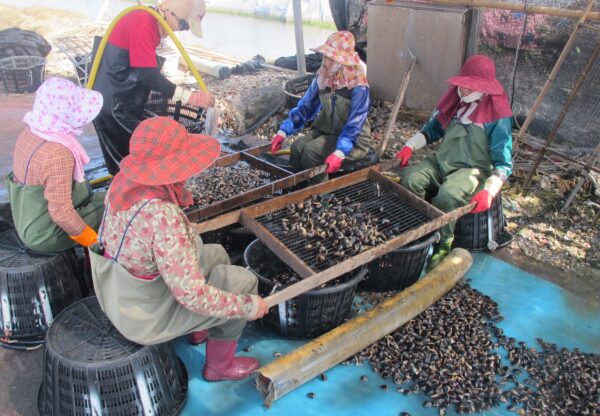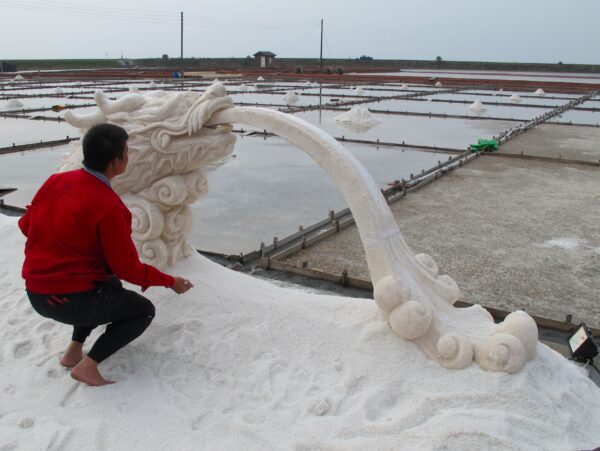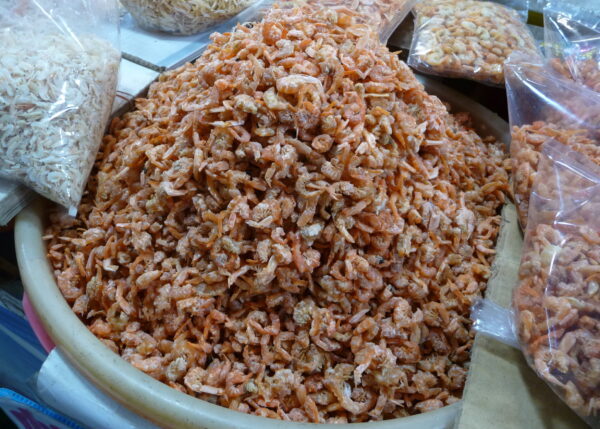
Washing and sorting clams in Qigu, southwestern Taiwan
Taiwan’s southwestern coast is littered with sites of cultural, culinary, and historical interest — so many that, with the help of an experienced driver-guide, it’s easy to spend an entire day working your way through Tainan’s ocean-facing districts, and then another doing the same in Chiayi and Yunlin.
The Southwest Coast National Scenic Area encompasses fishing harbours, several famous shrines, relics of the now-defunct salt industry, and some of the island’s finest winter birdwatching spots. It doesn’t matter if you travel from north to south or in the opposite direction, but it’s worth taking into account both the season and the time of day if you have particular priorities like witnessing one of the region’s rambunctious religious celebrations or watching the sun go down.

An artist sculpts a dragon from salt at Jingzaijiao, near Beimen in Tainan
Taijiang National Park
The southernmost part of the scenic area overlaps with Taijiang National Park, established in 2009 and named after a large lagoon that existed hereabouts until the 1820s, when devastating typhoons pushed so much silt into it that it became a patchwork of pools. The park’s mission goes beyond protecting important natural resources such as wetland ecosystems. It’s also responsible for preserving remnants of early Han Chinese settlement and manmade saltpan landscapes (a legacy of four centuries of saltmaking), while promoting the sustainable development of agriculture and fisheries.
There’s some uncertainty exactly where Koxinga (the military leader also known as Zheng Chenggong) landed in 1661, when he attacked the Dutch trading outpost at Fort Zeelandia, in what’s now Tainan’s Anping District. Most believe it was in the vicinity of Luermen, where — even if you care not a whit for history — you’re sure to be impressed by the size and grandeur of Orthodox Luermen Shengmu Temple. While you’re here, find the century-old ‘plague boat’ which drifted ashore here and the altar devoted to the Old Man Under the Moon (Yue Lao); he’s revered as a matchmaker deity who’s helped thousands find a husband or wife.
Qigu to Beimen
The district across the Zengwen River from Luermen is called Qigu. It’s pancake flat, baking hot in summer and swept by chilly winds between December and February. It’s associated with the black-faced spoonbill, a rare migratory waterbird, but the local economy is underpinned by fish farming rather than ecotourism. You won’t be surprised to learn that, if you know which restaurants to visit and what to order, you can enjoy some exceptional seafood. The locally-raised clams are especially good.
There’s yet more aquaculture in neighbouring Jiangjun, but the majority of tourists go there to see Qingkunshen Fan-Shaped Salt Field and its iconic Tree of Life, designed by papercut artist Yang Shih-yi. Come late afternoon, there’s sometimes quite a crowd.
Tucked into Tainan’s northwestern corner, the town of Beimen is the proud home of what could be Taiwan’s most-visited place of worship. Nankunshen Daitian Temple, a centre of Wang Ye (plague god) beliefs, was established even before Koxinga reached Taiwan. As with all shrines, to get the most out of a visit, arrive with a knowledgeable guide or read up beforehand. Weekends can be very lively indeed — and best avoided if you dislike noise, incense smoke, or the sight of blood. (Yes, you read that correctly: Some rituals feature spirit mediums who cut themselves to proove their divine patrons protect them from pain and serious injury.)
There’s something fishy about Budai…

Dried shrimp for sale in Budai Fish Market
Taiwanese people associate Budai, the first coastal town you come to when driving northwards from Tainan into Chiayi County, with fish. The seafood market here is always bustling with shoppers; it’s also a good place to get some lunch before heading off in search of black-faced spoonbills (in recent years, Budai has become almost as good as Qigu when it comes to seeing these graceful beauties) or fiddler crabs. If you drive or ride out to Haomeiliao — there are no public transport options — and position yourself on the mudflats, standing absolutely still for a minute or two will fool the crustaceans into thinking it’s safe to emerge from their burrows. Within a very short time, you’ll see hundreds of these lop-sided yet endearing creatures scuttling across the sand.
If you’re the kind of person who seeks appealing photos for your social media accounts, request to be driven the 800 m (0.5 miles) from Budai’s seafood market to the High-Heel Church. It isn’t actually a church (although some couples do hire it as a wedding venue) but rather a tender memorial to victims of black-foot disease, a problem in this region until the 1960s. Some of those afflicated, which included men and women, lost their feet due to the disease. The church is a striking assembly of blue glass panels; catch it when the light is right and it’s truly enthralling.
The sinking land of Shoudao
Translated into English, Shoudao means ‘Longevity Island’ but it’s neither an island nor — according to coastal geomorphologists — destined to be around for much longer. The utility poles and broken-down buildings on this tidal flat were connected to the salt industry. One of them was a police outpost: As recently as the 1970s, poverty in rural Taiwan was so severe that people would sneak onto salt-producing sites during the night and scoop up sackfuls of salt which they’d sell door-to-door.
Some see Shoudao’s slow inundation as a consequence of global warming, but the ocean’s gradual encroachment isn’t purely a result of rising sea levels. Here and at several other locations along the southwestern coast, overextracting groundwater for use in fish farms has resulted in land subsidence. In the past couple of years, driven by influencers and mainstream-media reports, there’s been a real ‘see it before it’s gone’ surge in the number of visitors coming to this otherwise very quiet corner of Chiayi County.
No public transport serves Shoudao, but if you’re on a private guided tour of Taiwan, your driver-guide can arrange not only to make a stop here but will also check the timing so as to guarantee that you’ll arrive at low tide or, if you prefer, sunset. Shoudao is around 20 minutes by car from Aogu Wetlands Forest Park which —like Qigu and Budai — is a prime spot for wintertime birdwatching.
In a sleepy village just outside Aogu, there’s an unusual religious site. Fuan Temple looks like hundreds of other halls of worships in Taiwan, but one of the deities revered here is the spirit of a Japanese police officer. He was posted here in 1900, just five years after the island became a colony ruled by Tokyo. In addition to maintaining law and order, Morikawa Seijiro endeavoured to boost literacy among the village’s younger inhabitants, and he often paid for medicine out of his pocket when impoverished locals were sick. When he advised his superiors that a new tax would impose great hardship on the area’s residents, he was accused of inciting non-payment. Protesting both this accusation and heavy-handed colonial rule, he took his own life. But local people didn’t forget him, later crediting his assistance from the next world during an epidemic. Deciding that he was worthy of veneration, they order the carving of a statuette that was then formally enshrined in Fuan Temple.
Start planning your trip today
Life of Taiwan’s expert itinerary designers are skilled at crafting travel plans that not just meet but exceed our clients’ expectations. Whether you aim to visit Taiwan with your family, focus on culture or food, or are obsessed with Taiwan’s world-class teas, we’d be delighted to host you and ensure you have the experience of a lifetime. Contact us today and get the ball rolling!
